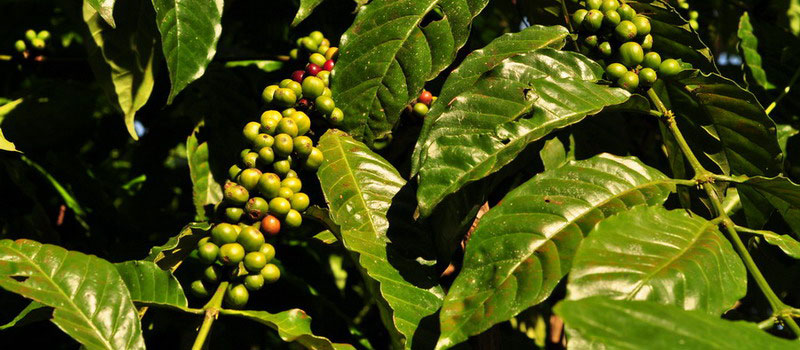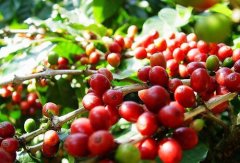What are the main ingredients of coffee beans?
The main ingredients of coffee
1. Caffeine
Caffeine is the most striking of all the ingredients of coffee and has a particularly strong bitter taste. It belongs to a kind of phytoxanthine (animal muscle component). It has the same properties as theophylline contained in cocoa, green tea contains the same theophylline, and the percentage of reduction after baking is very small. Caffeine has a very extensive effect. It will affect various parts of the human brain, heart, blood vessels, gastrointestinal tract, muscles and kidneys. The right amount of caffeine will stimulate the cerebral cortex, promote sensory judgment, memory and emotional activity, and make the myocardial machinery more active. Vasodilation enhances blood circulation and improves metabolic function. Caffeine can also reduce muscle fatigue and promote digestive juice secretion. Caffeine also promotes kidney function and helps get rid of excess sodium ions (chemicals that block the metabolism of water molecules). Caffeine does not accumulate in the body like other narcotic and excitant substances (* * products, paint solvents, stimulants, etc.) and is excreted after about two hours. But eating too much can lead to caffeine poisoning. The most important characteristic of coffee flavor, ─ bitterness, is caused by caffeine.
2. Tannic acid
After extraction, tannic acid will turn into a yellowish powder, which can easily blend into water, and after boiling, it will decompose and produce pyrosylic acid, which will make the coffee taste worse, and if it is brewed and left for several hours, the color of the coffee will become thicker than when it was just brewed, and it is also less tasty, so there is the saying that "it is best to drink it as soon as possible."
3. Fat
The fat in coffee plays a very important role in flavor. Analysis shows that there are many kinds of fat in coffee, the most important of which are acid fat and volatile fat. Acidic fat refers to the presence of acid in fat, whose strength varies with different types of coffee; volatile fat is the main source of coffee aroma, it is a kind of aroma that emits about 40 kinds of aromatic substances. Once the fat in roasted coffee beans comes into contact with the air, it will change chemically and taste worse.
4. Protein
The main source of calories is protein, and like dripping coffee, most of the protein will not dissolve, so no matter how much coffee you drink, the nutrition you get is limited, which is why coffee will become a sacred food for dieters.
5. Sugar
Raw coffee beans contain about 8% sugar. After roasting, most of the sugars are converted to caramel, which browns the coffee and combines with tannins to produce sweetness. Without sugar, you will not only feel the bitterness of caffeine and the sour taste of tannin, but also feel sweet, which is caused by the sugar contained in the coffee itself.
6. Minerals
The minerals in coffee are lime, iron, sulfur, sodium carbonate, phosphorus, chlorine, silicon and so on, which account for a very small proportion and have little effect on the flavor of coffee.
7. Crude fiber
The fiber of raw beans will be carbonized after baking, which combines with the caramelization of sugar to form the hue of coffee, but the fiber turned into powder will have a considerable impact on the flavor of coffee. Therefore, we do not encourage the purchase of powdered coffee beans, because this can not taste the flavor of the coffee.
8. The bitter acidity of coffee
The color, aroma and taste of coffee are caused by a series of complex chemical changes that take place during roasting. Therefore, raw beans must go through appropriate chemical procedures to achieve the most balanced state of its essential ingredients in order to be regarded as the best baked beans. The aroma of coffee changes with the heat, so the baking time should be shortened as much as possible, and the heat should be controlled at the lowest temperature that can produce effective chemical composition of coffee beans, that is, the time and heat of the shortest process, so that coffee beans can produce the most suitable composition ratio.
9. Fragrance
Aroma is not only the life of coffee quality, but also the best expression of coffee production process and roasting technology. Among them, the climate of the place of production, elevation, variety, refined treatment, harvest, storage, and the appropriateness of the baking technology of the consuming country are the conditions that influence the aroma of coffee beans. The results of gas chromatographic analysis showed that the aroma of coffee was composed of hundreds of volatile components such as acid, alcohol, acetaldehyde, ketone, ester, sulfur compound, phenol, nitrogen compound and so on.
Generally speaking, fat, protein and sugars are important sources of aroma, while lipids are mixed with the sour and bitter of coffee to form a smooth taste. Therefore, the disappearance of fragrance means that the quality is getting worse, and the relationship between aroma and quality is very close.

Important Notice :
前街咖啡 FrontStreet Coffee has moved to new addredd:
FrontStreet Coffee Address: 315,Donghua East Road,GuangZhou
Tel:020 38364473
- Prev

Coffee drinkers are more likely to succeed? Who drinks coffee?
Did you know that coffee drinkers are more likely to succeed? Why? Today, the editor will reveal the answer for you: 1. Coffee drinkers are more energetic. Coffee drinkers have caffeine in their blood all the time. Caffeine is like the fuel of the body. it stimulates adrenaline and improves the function of the body. Some experts say that drinking coffee an hour before exercise or competition can greatly improve you.
- Next

Coffee Nutrition composition Table the benefits of drinking Coffee
Coffee nutrition composition table contains 2.2 grams of moisture, 12.6 grams of protein, 16 grams of fat, 46.7 grams of sugar, 9 grams of cellulose, 4.2 grams of ash, 120 milligrams of calcium, 170 milligrams of phosphorus, 42 milligrams of iron, 3 milligrams of sodium, 20.12 grams of vitamin B20.12 grams, 3.5 milligrams of nicotinic acid, 1.3 grams of caffeine and 8 grams of tannins. Every 100 grams of coffee extract contains 99.5 grams of water, 0.2 grams of protein,
Related
- Beginners will see the "Coffee pull flower" guide!
- What is the difference between ice blog purified milk and ordinary milk coffee?
- Why is the Philippines the largest producer of crops in Liberia?
- For coffee extraction, should the fine powder be retained?
- How does extracted espresso fill pressed powder? How much strength does it take to press the powder?
- How to make jasmine cold extract coffee? Is the jasmine + latte good?
- Will this little toy really make the coffee taste better? How does Lily Drip affect coffee extraction?
- Will the action of slapping the filter cup also affect coffee extraction?
- What's the difference between powder-to-water ratio and powder-to-liquid ratio?
- What is the Ethiopian local species? What does it have to do with Heirloom native species?

